Having surveyed the academic issues and situated Tom Thomson within Canadian canoeing traditions, it’s appropriate now to look more attentively at the gear he used – how it affects my evaluation of his canoeing/camping cred – and for any insights it may provide into his life and times.
Tom Thomson’s canoe is at once the most visible and yet also controversial piece of gear. After examining photos and descriptions, I tend to agree with opinions expressed in forums on the website of the ‘Wooden Canoe Heritage Association,’ that Tom’s canoe was a 16′ Chestnut Cruiser – a wood and canvas model made in New Brunswick, about 1912. This model was the predecessor of the now very popular ‘Prospector’ design. 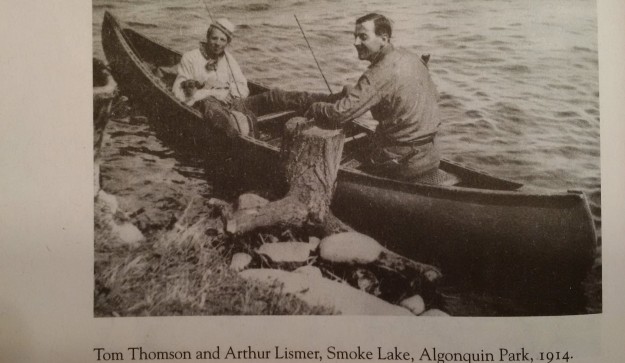
A great canoe; great design. Its construction materials have features still sought-after today: quiet passage through the water, nice thermal properties, reasonable repairability. In addition, Tom’s canoe appears to have cane seats and a stern-facing backrest in the bow (upgrades?).
However, wood and canvas canoes are fragile around rocks, and they do absorb water over time, adding to their initial heaviness. Tom’s canoe by 1917 – especially considering its alleged custom paint-job – probably exceeded 70lbs. This compares to as little as 40lbs for a modern, similar-sized high-tech kevlar/carbon craft.
A 16′ fiberglass Prospector canoe I used for decades, weighed about 65 lbs; my current canoe – an ex-rental 17′ Nova Craft Haida – weighs about 50lbs. 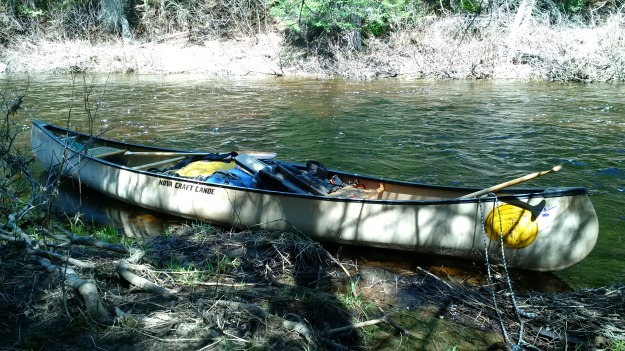
Tom Thomson’s canoe is kind of a Holy Grail today. Despite searches over the years, its whereabouts are unknown. It now seems to me that Tom may have owned and used more than one canoe while in Algonquin.
In a letter to Tom Harkness (executor of Thomson’s estate), dated August 6, 1917, Shannon Fraser, proprietor of Mowat Lodge where Thomson was headquartered, writes:
proprietor of Mowat Lodge where Thomson was headquartered, writes:
“I have seen the Rangers and they said the canoes [Tom’s] was worth $10.00 dollars a peace and they leak pretty bad they are Pretty old canoes and full of holes so they said that was all they are worth.”
This letter is quoted in Gregory Klages’ new book (“The Many Deaths of Tom Thomson,” 2016, Dundurn), but he does not comment on its significance with respect to Thomson’s canoe[s]. Yet, grammar and spelling aside, Fraser implies that Tom owned or had invested in a fleet of canoes at Canoe Lake. Perhaps this is connected to money Tom is rumoured to have lent Fraser to ‘buy canoes’ for Mowat Lodge.
My take is that Fraser deliberately down-played the canoes’ value so as to minimise his liability in the estate settlement. In general, this is not an uncommon situation when estates get messy – as Thomson’s did. It need not reflect too harshly on Fraser who seems to have been always on a thin edge financially. His comments do, however, add another rather unexamined mystery to Tom’s canoe inventory.
Tom Thomson’s canoe paddles are another essential piece of gear. They, too, are embroiled in controversy. How many paddles did he have? What role did they play in his fate? What happened to them?
I have pondered such questions from a canoeist’s perspective and, after reviewing the few available photos and contemporary testimony, have arrived at tentative conclusions.
First I will look closely at what information about the paddles themselves can be teased from available evidence. 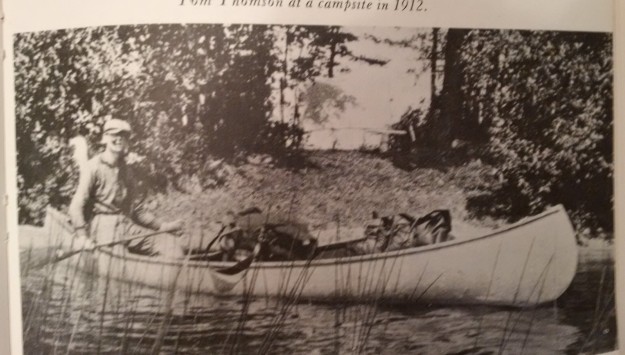
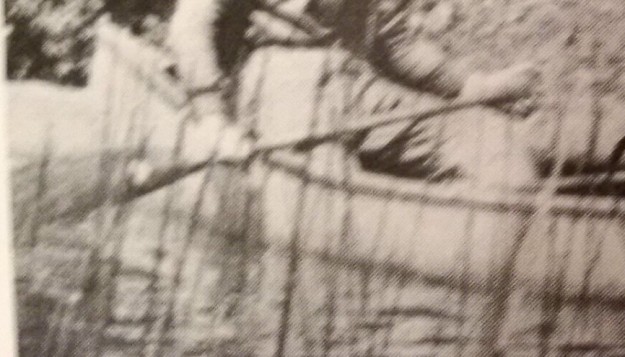 This photo, dated 1912, appears to be the only one in existence that shows Tom with a paddle.
This photo, dated 1912, appears to be the only one in existence that shows Tom with a paddle.
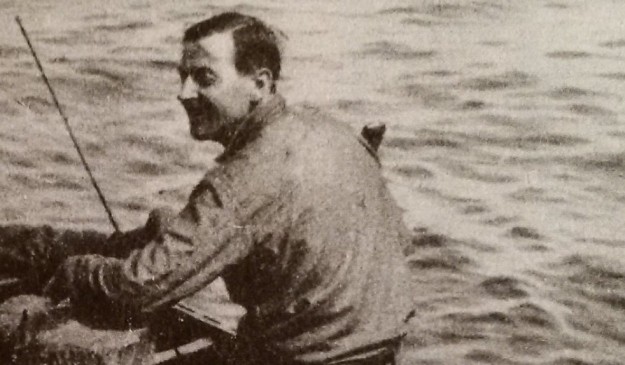 A previous photo, four back, shows a (the same?) paddle hand-grip near his right shoulder.
A previous photo, four back, shows a (the same?) paddle hand-grip near his right shoulder.
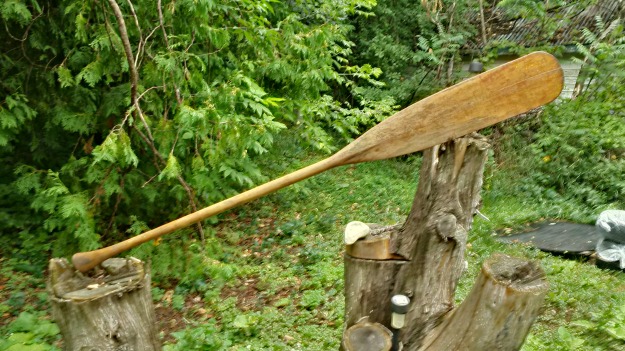 I believe the paddle to be similar to one I have in my own ‘collection.’ It dates from the 1940’s, perhaps much earlier. Note the curved handgrip and spline where shaft meets blade, similar to Tom’s (his paddle appears to have a round decal on upper blade). Total length is 59″ – perfect for a six-footer. Material is beech, and the overall dimensions make for a very well-balanced paddle.
I believe the paddle to be similar to one I have in my own ‘collection.’ It dates from the 1940’s, perhaps much earlier. Note the curved handgrip and spline where shaft meets blade, similar to Tom’s (his paddle appears to have a round decal on upper blade). Total length is 59″ – perfect for a six-footer. Material is beech, and the overall dimensions make for a very well-balanced paddle.
Tom is reputed to have had a “favourite ash working paddle,” which was lost. This is quite possible, as ash paddles have been in wide use in Algonquin since the Park’s inception (see a selection of old ash paddles displayed in the Portage Store restaurant at Canoe Lake).
 For example, the paddle pictured on the right is a 1940-50’s working ash paddle I found deep within Algonquin’s interior, and for which I subsequently traded with the MNR. These paddles were locally made, most likely by Avery & Sons of Whitney, Ontario (Algonquin East Gate), still a going concern today. The small maple paddle on the left is labelled as an Avery, and the design similarities are apparent. Ash paddles are noted for their strength and flexibility.
For example, the paddle pictured on the right is a 1940-50’s working ash paddle I found deep within Algonquin’s interior, and for which I subsequently traded with the MNR. These paddles were locally made, most likely by Avery & Sons of Whitney, Ontario (Algonquin East Gate), still a going concern today. The small maple paddle on the left is labelled as an Avery, and the design similarities are apparent. Ash paddles are noted for their strength and flexibility.
How many paddles did Tom Thomson own? Quite a selection, I believe – to go with the several canoes he apparently owned at Mowat Lodge.
When canoeing himself, the preponderance of evidence convinces me that he routinely carried two paddles, as per standard practice. In this, I’m in agreement with Gregory Klages who, based upon on-the-spot letters from Shannon Fraser, concludes that Thomson usually carried only two paddles (pp 230-2). Additionally, a third paddle would obviously have been an unnecessary encumbrance on portages.
However, Klages (spoiler alert) inadvertently undermines his central thesis which supports the official finding that Tom Thomson’s death was caused by ‘accidental drowning’ (p234 etc).
Because – and again from my canoeist’s viewpoint – the number and disposition of Tom’s paddles raises serious implications with respect to his subsequent fate.
To wit: his routine when preparing to portage would have been thus:
1. Step out from the canoe at the landing.
2. Lift out accessible packs to lighten the canoe.
3. Haul the canoe further out of the water and remove remaining gear.
4. Rig the canoe for carrying by tying the two paddles inside to form a rudimentary shoulder yoke.
He would then be ready to proceed, making one or more trips depending on load (ie. length of trip).
At no point would Tom have been out on the water with paddles already tied-in for portaging (would’ve interfered with pack placement and accessibility of spare paddle). The existent photos of Tom on the lake in his canoe, clearly show this to be the case.
Tom was last seen alive on July 8, 1917. His(?) canoe was reported floating upside down later that same day, but apparently was not recovered until July 10. His body was found, also floating, on July 16. Both canoe and body were found in the deep open waters of northwest Canoe Lake.
The obvious question is, how did Tom Thomson’s canoe and body relocate from a putative portage, to deep water? To the best of my knowledge, there are no existing portages in the vicinity of Canoe Lake where he was found. The closest trail – a largely abandoned path at Whiskey Jack Creek – does not alter this scenario.
If Tom had slipped on a portage (say, on the rocky ‘official’ portage into Gill Lake), how did his canoe end up so quickly back out on the lake? How could he have paddled there, perhaps injured, when both paddles were apparently found lashed in the canoe? Even if Tom did utilise a third ‘padding paddle,’ this does not change the ‘forensic scholarly’ finding that he was preparing to portage and thus was off the water.
To summarize the paddle situation: two paddles, tied in Tom’s canoe floating out on Canoe Lake, don’t support the official verdict of death by accidental drowning. Instead, they raise more questions. The probability of a long-suspected ‘third-party’ involvement, is strengthened in this scenario. And for now,that’s as far as I’ll go along those lines.
Suffice to say that, the official version of Tom Thomson’s death does not square with important physical evidence reported in the immediate aftermath.
Leaving aside such constraints for now, more mundane but nonetheless germane information about Tom’s other canoeing gear can be gleaned from photos and first-hand accounts. I touch on his artist’s tools in later Log entries.
 Tom’s pack was a traditional canvas canoe pack, little-changed for the past century and identical to my 1960’s Woods #1 Special pictured above. Recent cheap imported versions of these ‘Made in Canada’ originals, are not nearly as durable.
Tom’s pack was a traditional canvas canoe pack, little-changed for the past century and identical to my 1960’s Woods #1 Special pictured above. Recent cheap imported versions of these ‘Made in Canada’ originals, are not nearly as durable. 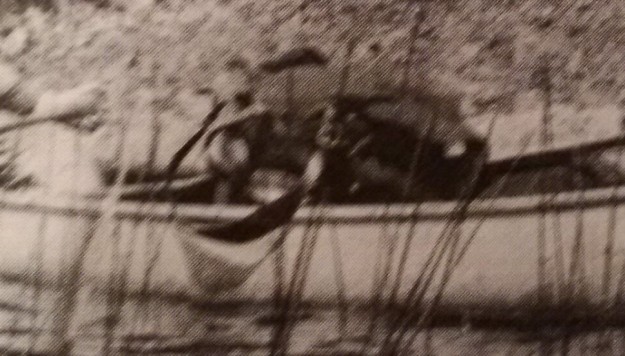
A distinctive feature of this pack is the attached short ‘tump’strap. You don’t see these used much now, but they were required in Tom’s day, when loads were heavier and necks were stronger. He also carried a tarp (rubber?) rolled up in a long standalone tump-line, as used in the following photo: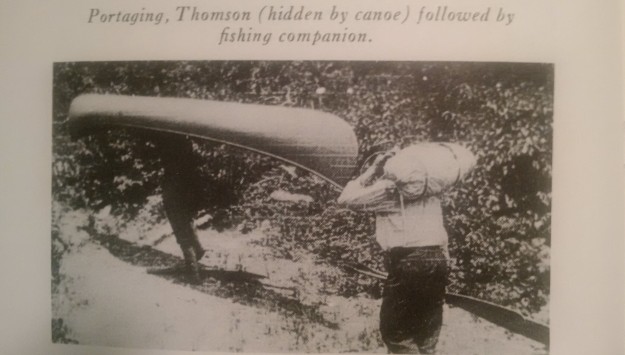
While these old canvas packs had great durability, they were not inherently waterproof and were available in a limited range of sizes. For these reasons, they have been supplanted to a large degree by plastic packs which even permit a watertight closure, allowing the pack to float in case of upset.
However, the new plastic packs are susceptible to puncture and I’d bet that, unlike the old canvas packs, few will be around fifty years from now.
Perhaps the last large item of Tom’s camping/canoeing gear is his tent.  It was a classic ‘A-frame.’ Versatile, easy to pitch; with pegs, poles, and often bedding cut from surrounding forest. Materials were light canvas (poplin) and rubber ground-cloth.
It was a classic ‘A-frame.’ Versatile, easy to pitch; with pegs, poles, and often bedding cut from surrounding forest. Materials were light canvas (poplin) and rubber ground-cloth. 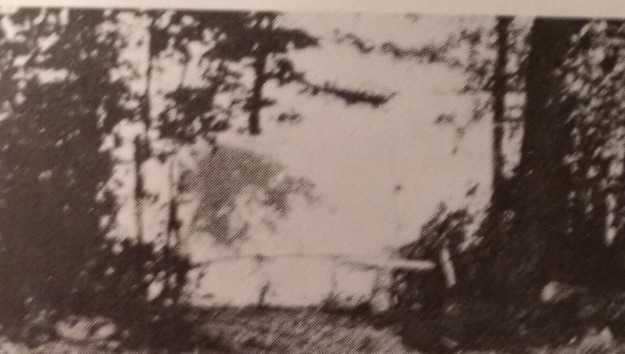 Real luxury would’ve been some kind of bug screen combined with the Hudson Bay blanket(s) Tom reportedly used.
Real luxury would’ve been some kind of bug screen combined with the Hudson Bay blanket(s) Tom reportedly used.
Although potentially more weighty and less waterproof compared to modern designs, the great utility (four seasons) of the old A-frame has such undiminished desirability for ‘workplace’ camping, that Rutstrum developed and marketed his own adaptable version which still commands a niche following today.
Before considering what foods Tom brought while canoeing, I’ll look at a couple of smaller items in his kit.
Tom carried a knife that, I believe, was used primarily for filleting fish and other culinary endeavors. 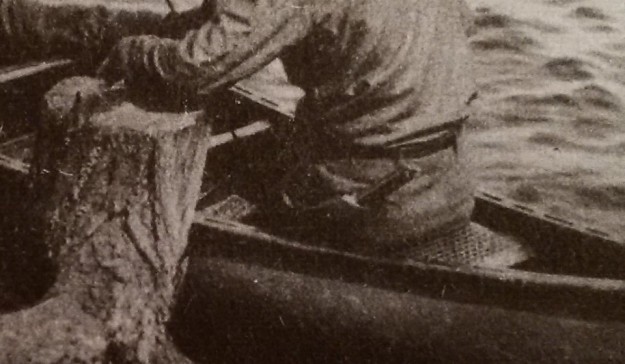 Judging from the photo – the only one I’m aware of that shows his knife – I’m undecided as to whether it reveals a heavy ‘tang’ (ie. Bowie style) or is simply a sheathed, long-handled filleting knife. In any case, in Tom’s time there was a limited selection available. Quite likely his knife was made in Sheffield, England by Charles Ibbotson&Co. (ie.’Early Bird’), comparable to these in my ‘collection:’
Judging from the photo – the only one I’m aware of that shows his knife – I’m undecided as to whether it reveals a heavy ‘tang’ (ie. Bowie style) or is simply a sheathed, long-handled filleting knife. In any case, in Tom’s time there was a limited selection available. Quite likely his knife was made in Sheffield, England by Charles Ibbotson&Co. (ie.’Early Bird’), comparable to these in my ‘collection:’ 
If you ask an old woodsman what tool he’d choose if allowed to take only one into the wilderness, I bet he’d say, “axe.” With an axe a skilled person can create shelter, access wild food, defend themselves, and even shave. It is, however, important to distinguish between an axe and a hatchet. The latter (small head, handle 1′ or less) is an inefficient, dangerous tool (miss a stroke with an axe, most likely blade hits ground; miss with a hatchet, blade more readily strikes leg or hand).
Tom Thomson carried an axe in the bush, and although I’ve not been able to locate any photos of it, I believe it probably was of the ‘Hudson Bay’ style. This design features a relatively broad blade-edge combined with smaller and hence lighter poll. Yes, I happen to have an example in my collection – a “Genuine Norlund” from mid 1960’s Canadian Tire: 
In her 2012 book about Algonquin Park’s Smoke Lake, Gaye I. Clemson quotes Esther Keyser who established a canoe-trip business in the Park in the 1930’s: “I was proficient with the Hudson Bay axe…” indicating perhaps early widespread usage of this axe design in Algonquin.
Given the importance of an axe in any canoeist’s kit of Tom’s time, it’s all the more puzzling that he left his on the dock when departing on what turned out to be his final trip (as per Robinson’s July 1917 Journal entry).
To me this indicates that Tom was embarking on a quick errand, with the intention of returning shortly to complete his interrupted(?) packing for a longer excursion.
In addition to the axe he also left “three old tin pails” on the dock – no doubt a good part of his cooking gear, further reinforcing my impression that he was intending to be gone only briefly.
The apparent brevity and errand-like quality of Tom’s initial departure that day, July 8/17, further erodes the official version of events that claims he was preparing to portage, fell, struck his head, and subsequently accidently drowned.
An item of his kit not accounted for in Tom’s ensuing estate but that nonetheless was central to his mode of procedure, is his reflector-oven. 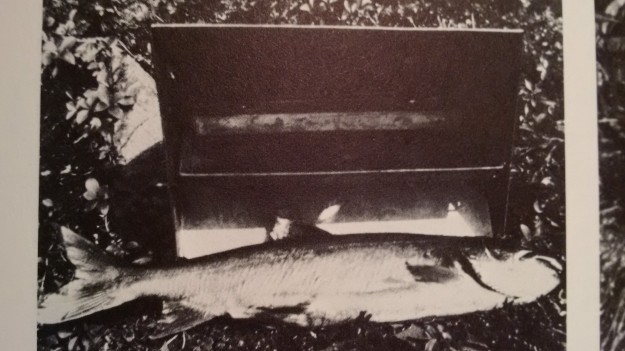 This kind of folding oven, widely relied on by ‘workplace’ canoeists, no doubt allowed Tom to live partly off the country through his fishing.
This kind of folding oven, widely relied on by ‘workplace’ canoeists, no doubt allowed Tom to live partly off the country through his fishing.
Besides fish, Tom’s bush diet appears to have been high in carbs. His fondness for maple syrup and jam is well illustrated in his food lists and related documents. For instance, Mark Robinson noted that “1 gal can maple syrup, 1.5lbs tin of jam” were recovered from his empty canoe (July 1917). And Tom himself provided this grubstake in a letter dated May 8, 1917 (Addison/Harwood, 1975, pp 62-3):
“I have all the supplies including 1 gallon maple syrup pail of jam plenty bacon, potatoes, Bread, tea, sugar, all kinds canned stuff…”
These kinds of foods – typical for the time among working wilderness travellers – have important implications when trying to understand and evaluate Tom Thomson’s accomplishments as canoeist/ camper.
For instance, Tom’s favourite ‘gallon of maple syrup’ would’ve weighed almost 15 lbs. In comparison I’ve calculated that a similar weight of modern freeze-dried food such as I routinely use now on canoe trips, would provide three squares per day for two people for ten days, and these would be gourmet meals, simply prepared. All the rest of Tom’s foods were similarly cumbersome, although certainly sustaining.
Have you ever actually tried to prepare hot meals over an open wood-fire in wilderness conditions? And in all weather conditions? Fishing for food sounds great, but the mess and tedious prep requirements can quickly overwhelm the dilettante until he / she hightails it back to the Portage Store Restaurant, where a nice Tom Thomson Burger can be ordered.
The fact is, to successfully use Tom’s canoeing / camping tools and techniques much beyond a weekend novelty, requires skill of a very high order. That he was able to also create art of the highest caliber, attests further to his extraordinary accomplishments.
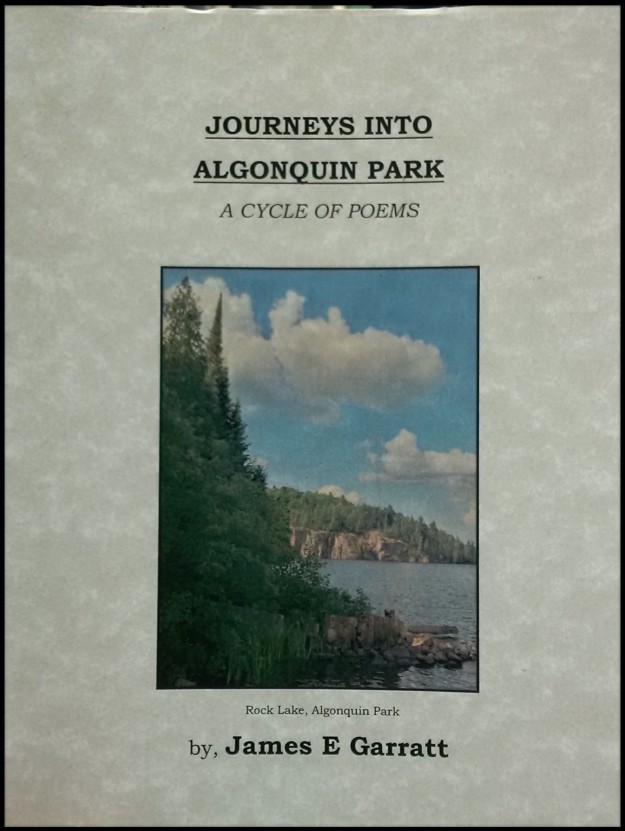
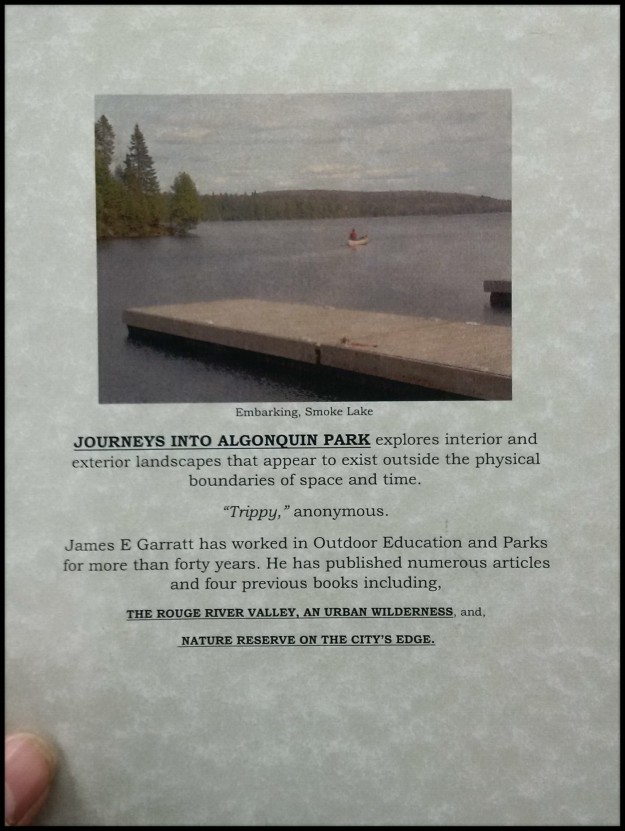





 proprietor of Mowat Lodge where Thomson was headquartered, writes:
proprietor of Mowat Lodge where Thomson was headquartered, writes:
 This photo, dated 1912, appears to be the only one in existence that shows Tom with a paddle.
This photo, dated 1912, appears to be the only one in existence that shows Tom with a paddle. A previous photo, four back, shows a (the same?) paddle hand-grip near his right shoulder.
A previous photo, four back, shows a (the same?) paddle hand-grip near his right shoulder. I believe the paddle to be similar to one I have in my own ‘collection.’ It dates from the 1940’s, perhaps much earlier. Note the curved handgrip and spline where shaft meets blade, similar to Tom’s (his paddle appears to have a round decal on upper blade). Total length is 59″ – perfect for a six-footer. Material is beech, and the overall dimensions make for a very well-balanced paddle.
I believe the paddle to be similar to one I have in my own ‘collection.’ It dates from the 1940’s, perhaps much earlier. Note the curved handgrip and spline where shaft meets blade, similar to Tom’s (his paddle appears to have a round decal on upper blade). Total length is 59″ – perfect for a six-footer. Material is beech, and the overall dimensions make for a very well-balanced paddle. For example, the paddle pictured on the right is a 1940-50’s working ash paddle I found deep within Algonquin’s interior, and for which I subsequently traded with the MNR. These paddles were locally made, most likely by Avery & Sons of Whitney, Ontario (Algonquin East Gate), still a going concern today. The small maple paddle on the left is labelled as an Avery, and the design similarities are apparent. Ash paddles are noted for their strength and flexibility.
For example, the paddle pictured on the right is a 1940-50’s working ash paddle I found deep within Algonquin’s interior, and for which I subsequently traded with the MNR. These paddles were locally made, most likely by Avery & Sons of Whitney, Ontario (Algonquin East Gate), still a going concern today. The small maple paddle on the left is labelled as an Avery, and the design similarities are apparent. Ash paddles are noted for their strength and flexibility. Tom’s pack was a traditional canvas canoe pack, little-changed for the past century and identical to my 1960’s Woods #1 Special pictured above. Recent cheap imported versions of these ‘Made in Canada’ originals, are not nearly as durable.
Tom’s pack was a traditional canvas canoe pack, little-changed for the past century and identical to my 1960’s Woods #1 Special pictured above. Recent cheap imported versions of these ‘Made in Canada’ originals, are not nearly as durable. 

 It was a classic ‘A-frame.’ Versatile, easy to pitch; with pegs, poles, and often bedding cut from surrounding forest. Materials were light canvas (poplin) and rubber ground-cloth.
It was a classic ‘A-frame.’ Versatile, easy to pitch; with pegs, poles, and often bedding cut from surrounding forest. Materials were light canvas (poplin) and rubber ground-cloth.  Real luxury would’ve been some kind of bug screen combined with the Hudson Bay blanket(s) Tom reportedly used.
Real luxury would’ve been some kind of bug screen combined with the Hudson Bay blanket(s) Tom reportedly used. Judging from the photo – the only one I’m aware of that shows his knife – I’m undecided as to whether it reveals a heavy ‘tang’ (ie. Bowie style) or is simply a sheathed, long-handled filleting knife. In any case, in Tom’s time there was a limited selection available. Quite likely his knife was made in Sheffield, England by Charles Ibbotson&Co. (ie.’Early Bird’), comparable to these in my ‘collection:’
Judging from the photo – the only one I’m aware of that shows his knife – I’m undecided as to whether it reveals a heavy ‘tang’ (ie. Bowie style) or is simply a sheathed, long-handled filleting knife. In any case, in Tom’s time there was a limited selection available. Quite likely his knife was made in Sheffield, England by Charles Ibbotson&Co. (ie.’Early Bird’), comparable to these in my ‘collection:’ 

 This kind of folding oven, widely relied on by ‘workplace’ canoeists, no doubt allowed Tom to live partly off the country through his fishing.
This kind of folding oven, widely relied on by ‘workplace’ canoeists, no doubt allowed Tom to live partly off the country through his fishing.
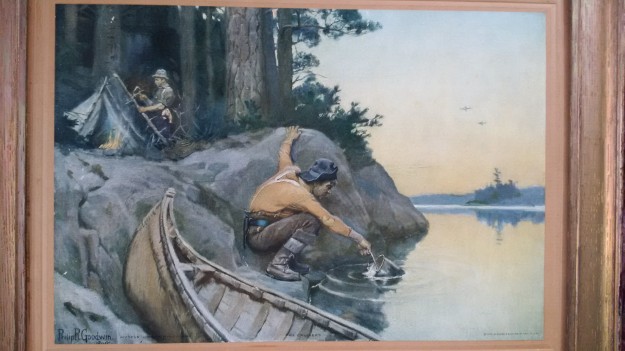

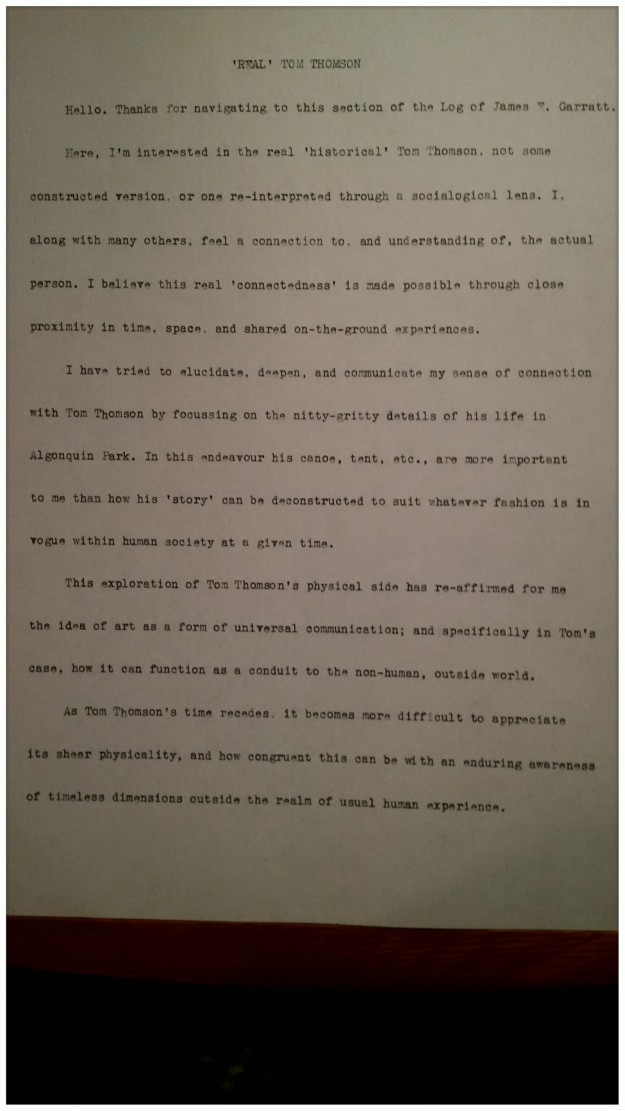 Modern art critics and academics have fairly uniformly tended to downplay the ‘skilled woodsman’ aspect of Tom Thomson. They have apparently seen it as getting in the way of a true, demythologized evaluation of his art. Answering to egalitarian times, they have wanted to ‘normalize’ Tom as far as possible: His canoeing was ordinary; the wilderness he traveled, not so wild.
Modern art critics and academics have fairly uniformly tended to downplay the ‘skilled woodsman’ aspect of Tom Thomson. They have apparently seen it as getting in the way of a true, demythologized evaluation of his art. Answering to egalitarian times, they have wanted to ‘normalize’ Tom as far as possible: His canoeing was ordinary; the wilderness he traveled, not so wild.